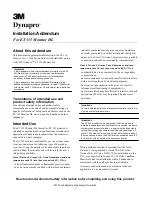
WCB 11060 (PDF Format)
7
© Copyright Eaton Corp., 1998. All rights reserved
June, 1998
1.0
INTRODUCTION
Throughout this manual there are a number
of HAZARD WARNINGS that must be read
and adhered to in order to prevent possible
personal injury and/or damage to the equipment.
Three signal words “DANGER”, “WARNING”,
and “CAUTION” are used to indicate the
severity of the hazard, and are preceded
by the safety alert symbol
.
Denotes the most serious injury
hazard, and is used when serious
injury or death WILL result from
misuse or failure to follow specific
instructions.
Used when serious injury or death
MAY result from misuse or failure to
follow specific instructions.
Used when injury or product/
equipment damage may result
misuse or failure to follow specific in-
structions.
It is the responsibility and the duty of all
personnel involved in the installation, opera-
tion and maintenance of the equipment on
which this device is used to fully understand
the
,
and
procedures by which hazards are to be avoided.
1.1
Description
1.1.1
The Airflex WCB water-cooled tensioner is
designed for constant tension applications.
It is exceptionally well suited for high inertia
stopping and rapid heat dissipation. The
design of the WCB tensioner permits
midshaft or endshaft mounting. The rugged
construction ensures long, trouble free
service. Several models are available having
single and multiple friction discs. The
tensioner model number identifies the num-
ber of discs and the disc diameter. For
example, 124WCB means one 24" diameter
disc. When size, such as 24WCB, is referred
to in this manual, it means that the informa-
tion given applies to all models using the 24"
diameter disc; i.e., 124WCB, 224WCB, etc.
1.1.2
This manual covers WCB models with “J”
(146XXXJ) designator that have Corrosion
Resistant Pistons and Standard screwed on
friction linings (8) and WCB models with “K”
(146XXXK) designators that have Corrosion
Resistant Pistons and High Coefficient
screwed on friction linings.
1.1.3
Tensioners can be used for either closed loop
or open loop water systems.
1.1.4
This manual includes metric equivalent
usually shown in (#) following the U.S.
measurement system value. Be sure to
use the correct value.
1.2
How It Works
1.2.1
Refer to Figure 1. Air is introduced to the unit
causing the pressure plate assembly (13) to
move and make contact with the friction discs
(8). Torque is transmitted through the studs
(6) to the mounting flange (2). The release
springs (34) assist in disengagement and re-
traction of the piston (33) and pressure plate.
High heat dissipation is accomplished by
passing water through a special cavity
behind copper wear plates (3).









































